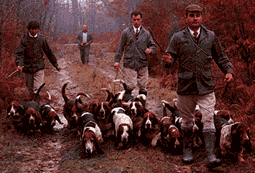
Reprinted with permission
of S. Levoye
The Basset Hound originated in sixth-century France, a country known for its many strains of hounds. Most strains had a tall version as well as a short-legged size under sixteen inches, which were called “Basset” (bas in French means low-set). Both the Basset Hound and its long-legged cousin, the Bloodhound are thought to be descendants of the famed St. Hubert hounds.